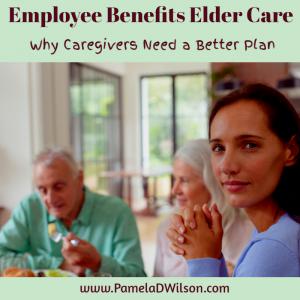Employee Benefits Elder Care: Why Caregivers Need a Better Plan
The coronavirus intensified caregiving responsibilities;is the virus the wake-up call corporations need to make elder care a part of employee wellness programs?
GOLDEN, COLORADO , USA, May 18, 2020 /EINPresswire.com/ -- Most employee wellness programs do not address elder care needs for working caregivers. The coronavirus and escalating stress about caregiving responsibilities are a wake-up call that caregivers need a better long term plan.
Caregivers experience chronic stress resulting from the role strain of caregiving and work. More than one-fourth of caregivers are responsible for the care of two or more family members and confirm that caregiving has made their health worse according to the study Caregiving in the US 2020.
If Whole-Family Care Why Not Elder Care?
Maternity leave, paternity leave, and childcare programs are a component of employee wellness programs. Family care programs seek to reduce stress and burnout that translates to employee absenteeism, turnover, and low productivity.
Caregiver stress is significantly higher for caregivers than for non-caregivers. Female caregivers have higher levels of depression, anxiety, and lower life satisfaction. Women in mid-life experience physical disabilities that add to the challenges of caring for elderly parents and spouses.
ROI of Employee Wellness Programs
The role of women as caregivers is well-known. Families expect women—not men— to be the family caregiver. If corporations offer whole-family care, why aren’t human resource managers raising the flag to the c-suite about the importance of providing elder care programs?
C-suite concerns may be that current employee wellness programs—with high financial incentives to bolster employee participation—show a marginal effect in reducing skyrocketing healthcare costs or improving employee health. The cost of implementing employee wellness programs is a valid concern.
Low ROI is the reason for reaching out to overlooked working caregivers. Increasing awareness and the consequences of caregiving responsibilities address the missing link between wellness programs, insurance, and financial planning.
Caregivers Worry About Money
The role strain of caregiving and working is the reason that women opt-out and return to the workforce up to three times during life. Working women leave and re-enter the workforce after raising children, caring for elderly parents, and a sick spouse.
Couples rarely talk about the long term financial impact of non-working wives. According to a Merrill Lynch study, Women and Financial Wellness, the average woman spends 44% of her adult life out of the workforce compared to a man at 28%. When a woman reaches retirement age, she may earn a cumulative $1,055,000 less than a man who has stayed continuously in the workplace.
Families caring for elderly parents contribute $3-7,000 a year on average for the care of elderly parents. As care needs increase and care costs rise, by an average of 6% a year, working caregivers worry about not having enough money to help elderly parents.
Who Cares for the Caregiver?
Married couples rarely converse about funding care costs for the surviving spouse. This absent discussion affects the working caregiver helping the healthy parent care for the sick parent. This lack of financial planning falls to the next generation and the primary caregiver.
Wives trust husbands to plan for the long term. A UBS study confirms that 56% of women leave investment and long-term financial planning decisions for their husbands. Eighty-five percent of women who defer to their husbands believe their spouses know more about financial matters.
Financial planners attempt to talk to couples about the costs of care. Couples delay decision-making until relevant discussions offered by caregiving expert, Pamela D. Wilson, share real-life examples of the consequences of family caregiving related to healthcare, money, and legal planning. Similarities exist with attorneys who attempt to encourage individuals to create estate plans.
Issues Families Don’t Talk About
The inherent risks of caregiving relate to a lack of understanding of consequences and what might happen next. Women, on average, live five years longer than men. By the time a husband passes away, the wife has spent many years as a caregiver. The family has spent the bulk, if not all, the financial resources on care for the husband. At this point, who cares for the surviving caregiver who is usually the wife?
The problem is that men, who are less involved in caregiving activities are more reluctant to see a doctor until health concerns are extreme. Delayed diagnoses that have progressed to the point of no return are part of the reason men die before women. Men are generally less comfortable talking about death than women. Working women who are the primary family caregivers need a better long term plan.
The Missing Link Between Elder Care and Employee Wellness Programs
As working caregivers become trapped by caregiving responsibilities, an opportunity exists to relate caregiving to healthy habits, insurance, and retirement planning to elder care needs. As a caregiving expert, Wilson relays real-life examples of care situations that create relevance between caring for elderly parents and the long term choices that caregiving employees make for themselves. Caregiver programs are the missing link in employee wellness programs.
Role strain and competing life priorities raise caregiver stress to the point of burnout. Caregiver burnout results in poor self-care and compromised care for elderly parents.
Caregiver burnout negatively affects workplace performance. Caregivers worry about being fired. Employees leave jobs when they realize that caregiving responsibilities are interfering with work.
Employee stress, burnout, absenteeism, low productivity, and turnover reduce when caregiver programs are available. Workplace conversations with supervisors about work schedules are another part of the employee wellness plan for caregivers. If the coronavirus has shown us anything, it has proven that remote work arrangements are possible.
Elder Care Programs Drive Loyalty
Corporations with elder care programs retain valuable employees. Elder care programs increase awareness of the aspects of caregiving, offer caregiving education for the stages of caring for elderly loved ones, and provide ongoing support.
Support through life situations that caregivers find challenging increase employee loyalty. Caregivers who understand what it’s like to be a caregiver become elder care ambassadors. Caregivers are more receptive to other caregivers who communicate the benefits of the elder care program and encourage participation.
For more information call Pamela D. Wilson at 303-810-1816 or email Inquiry_For_Pamela@PamelaDWilson.com
Pamela D. Wilson
Pamela D. Wilson, Inc.
+1 303-810-1816
email us here
Visit us on social media:
Facebook
Twitter
LinkedIn
Employee Wellness Programs for Caregivers
Legal Disclaimer:
EIN Presswire provides this news content "as is" without warranty of any kind. We do not accept any responsibility or liability for the accuracy, content, images, videos, licenses, completeness, legality, or reliability of the information contained in this article. If you have any complaints or copyright issues related to this article, kindly contact the author above.



